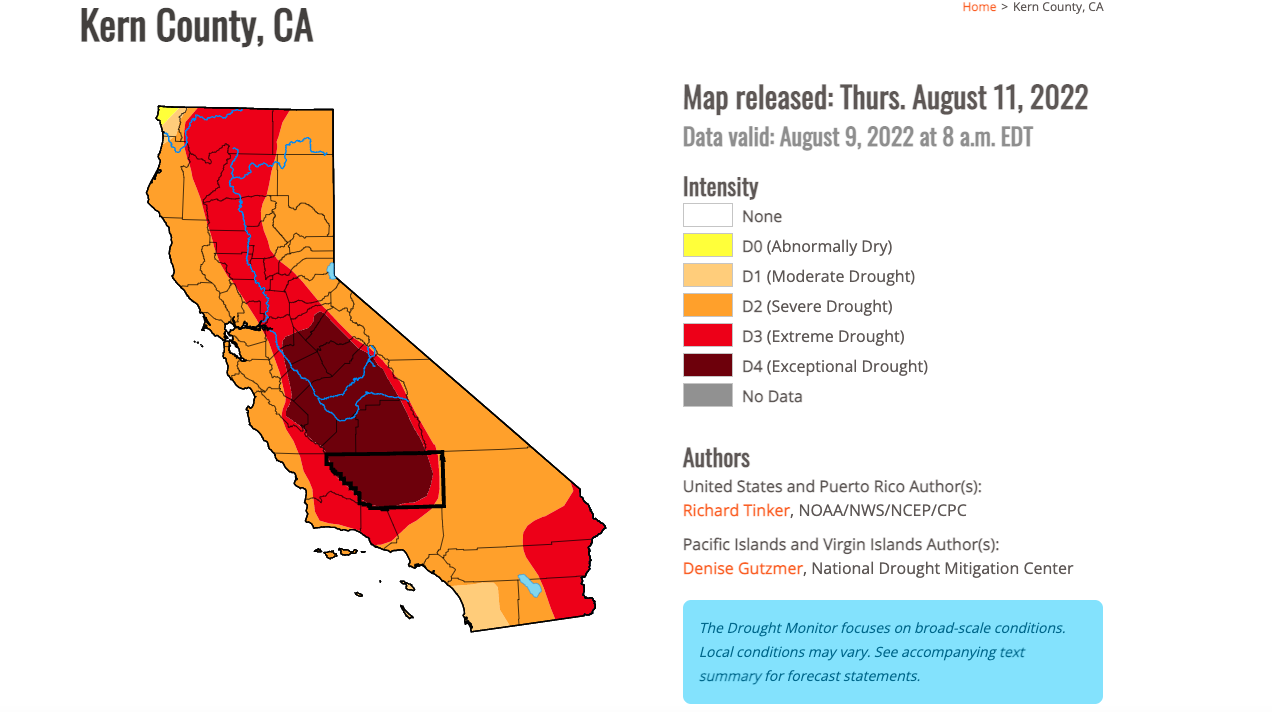BAKERSFIELD CALIF. (KERO) — As the entire state looks to save every drop of water possible, the Central Valley is seeing the worst of the drought. Almost all of Kern County is under the "Exceptional Drought" category, according to the state’s drought monitor.

As the water system in Kern County continues to do its job pumping and filtering the water before it hits our faucets so are the residents of Bakersfield when it comes to helping conserve that resource. According to statistics, water usage in the city decreased by almost 17% in June.
Tamara Johnson oversees the systems that bring water to more than 400,000 Bakersfield residents. She says people here understand the severity of the drought.
"Every gallon saved means a gallon possibly for tomorrow," said Johnson, the district manager for the California Water Service in Bakersfield. "They have received the messaging. They know we are in a crisis here, and they are starting to conserve their usage."
Looking at the state overall, Bakersfield is among those leading the way.
"In June, our Bakersfield district actually made the list of the top 72 water savers in the state," explained sot Yvonne Kingman, the director of corporate communication for the California Water Service.
And that, Kingman says, is out of the over 420 systems the state has.
"Achieved a savings rate of 15 percent or more and our Bakersfield district was among those 72 systems."
The state is slowly moving in the right direction.
"Compared to May, statewide, the water savings doubled in June compared to May," said Kingman.
Both Johnson and Kingman attribute this to people following the outside irrigation policies aimed at doing just this: limiting water usage. That is why despite this win in June, they say it doesn’t mean we put our guard down.
So their efforts are expanding, such as engaging with HOA’s, apartment complexes, and industrial places to identify what they call non-functional turfs and limit watering them. That was started just last month, and they expect to see substantial conservation as a result in the upcoming reports.
Cal Water also offers Water-Saving Landscaping Programs that include "a rebate of $3 per square foot of lawn removed. At least 50 percent of the grass removed must be converted to landscaping utilizing California-friendly, drought-tolerant plant material. Artificial/synthetic turf, lawn that is already dead, or grass previously removed do not qualify for the rebate." They also offer a "spray-to-drip program provides a rebate of $0.50 per square foot of landscaping converted from a standard spray irrigation system to a drip system, as drip irrigation uses 20 to 50 percent less water compared to sprinklers." You can also find out what other rebates you might be eligible for on the Cal Water website.
Lawn Be Gone: Achieve Big Water Savings by Ditching the Grass
How Much Water Can You Save By Removing Your Lawn?
California and the western United States are experiencing a severe climate-driven drought. Our drought requires urgent action, so it’s time to double down.
One of the most effective ways to do this is by removing or reducing the size of your lawn. About half of residential water use is spent outdoors on lawn and landscaping.
Why Is My Lawn the Culprit?
Grass uses twice as much water as most other plants in your yard. Grass also requires frequent maintenance (the constant mowing, edging, and fertilizing) to stay lush and healthy. The good news is that there are alternatives to grass that are just as attractive and appealing to your property! You can find many plants that require less water in our guide here: Water-Wise Plants
What Areas of Grass Should I Remove?
Areas that are hard to maintain or serve no function as usable space are top candidates for removal. This includes spaces such as parkways, slopes, and areas near driveways, or sidewalks as they are difficult to water efficiently. Remember, these areas can be replaced with beautiful and low-maintenance California native plants!
Johnson and Kingman agree that every effort counts.
"The proof is there we collectively saved from our Bakersfield district 16.9% in June. So it does add up and it does make a difference," said Kingman. "So we never want someone to think that they don't matter, or their efforts don't matter because you can see that it really does."
Because the efforts don’t end here, there are many ways to conserve water. The California Department of Water Resources has the following tips on how to conserve water:
Indoor Conservation Tips
- Fix leaks, including leaky toilets
- Install high-efficiency toilets, aerators on bathroom faucets, and water-efficient shower heads
- Take shorter (5-minute) showers
- Track your water bill and meter to curtail water use
- Turn off the water when brushing teeth or shaving
- Use dishwashers and washing machines with full loads only
Outdoor Conservation Tips
- Plant drought-tolerant/resistant plants and trees
- Recycle indoor water to use on plants
- Refrain from watering your home landscape when it rains
- Replace your grass/turf with water-wise plants
- Use a broom to clean driveways, patios, and sidewalks instead of water from a hose
- Water your outdoor landscape earlier in the day when temperatures are cooler


